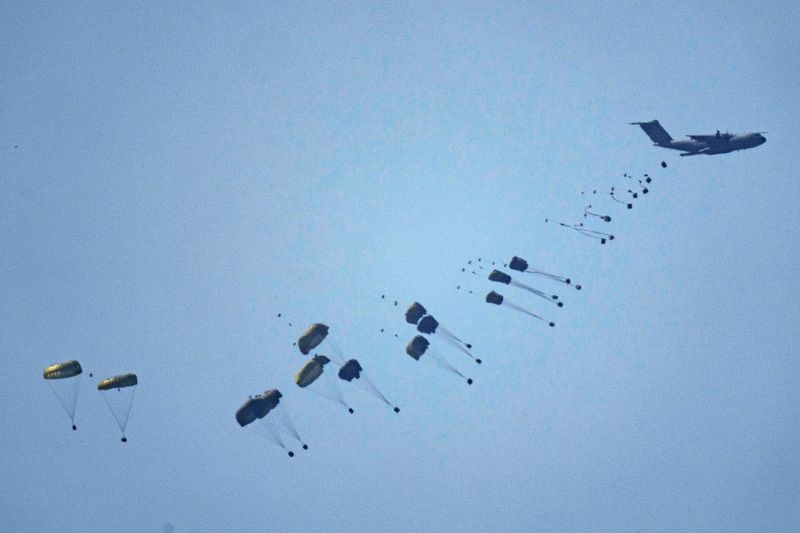The US has joined several other countries in airdropping aid into Gaza, which is grappling with a humanitarian crisis.
With aid deliveries on land falling far short of the numbers needed to ward off famine in the enclave, it is hoped these airdrops will provide a lifeline to people in Gaza.
But the UN and aid agencies have questioned how effective they will be at alleviating the situation, and their risks were shown starkly on Friday when malfunctioning parachutes caused aid pallets to hurtle from the sky at breakneck speed, killing five unsuspecting civilians.
We’ve been taking a closer look at the use of airdrops in warzones.
What are airdrops?
The UN carried out its first airdrop in August 1973 and since then they have been used by aid agencies and governments to deliver food to conflict zones across the globe.
Packages of food and medicines are wrapped typically with six layers of packaging to provide protection and sewn together using a handheld stitching machine. Agencies use different colors to denote the contents of the packages with the World Food Programme using white for cereals, red for pulses and blue or green for specialized nutritious food.
Packages are then loaded onto aircraft before being dropped via parachute anywhere from 300 to up to 5,600 meters above, according to the World Food Programme (WFP).
This is not the first time the US government has carried out airdrops over conflict zones. In 2001, the US dropped food packets over Afghanistan accompanied by leaflets explaining how civilians could tell the difference between airdrops and cluster bombs. In 2014, when Islamic State was at its peak in Iraq, the US dropped aid into areas where food and water supplies had been cut.
Do they work?
Airdrops evade the often rigorous examinations carried out at land checkpoints, so are undoubtedly a speedy way of getting supplies into a conflict zone.
But despite this advantage, aid agencies say their drawbacks overwhelmingly outweigh their benefits.
For starters, they are more expensive. Airdrops cost up to seven times as much as land deliveries, the WFP says. They also have much more limited delivery capacity. For example, one truck is capable of delivering nearly 10 times the amount one aircraft could deliver- roughly 20 to 30 metric tonnes, according to the UN.
“Humanitarian workers always complain that airdrops are good photo opportunities but a lousy way to deliver aid,” Richard Gowan, the International Crisis Group’s UN Director said.
Experts have also questioned whether countries have plans in place for the aid once it reaches the ground. The UN special rapporteur for food, Michael Fakrhi says airdrops usually culminate in chaos.
“You’re throwing aid into the wind to people who’ve been starving and have been denied humanitarian access. This will create chaos, predictably, and we cannot blame the people for that,” Fakrhi said Friday.
Palestinians have voiced some practical concerns. Mahmoud Shalabi who is senior program manager of NGO, Medical Aid for Palestinians (MAP), said some meals needed microwaves when “we don’t even have electricity right now.” Speaking from the city of Beit Lahia in northern Gaza, Shalabi said most packages have only contained enough food for just two to three meals.
A Palestinian journalist based in northern Gaza, Abdel Qader Al Sabbah said the wrong type of meals were being sent, calling instead for “flour, rice, oil, salt, and other seeds and beans, so people here can benefit from these and prepare several meals.”
So why are airdrops being carried out?
Aid agencies have consistently said not enough aid is reaching Gaza.
Even before the war, Israel restricted access and to and from Gaza, stringently controlling the entry of goods through land crossings. After Israel imposed a “complete siege” on Gaza following the October 7 attacks controls have significantly tightened further.
Israel has been carrying out security checks on goods entering its own crossing into Gaza, Kerem Shalom but also on goods that passed through Israeli crossings before transiting onto Egypt’s entry point into Gaza, the Rafah crossing.
An average of 95 aid trucks per day entered Gaza between October 10 and February 1, according to the Palestinian Red Crescent, down from 500 commercial and aid trucks a day before the war. It is the challenges of getting aid via road that has prompted countries to carry out recent airdrops, to the dismay of organizations such as the UN who say they should only be used when all other options have been exhausted.
“When countries use airdrops and these maritime piers is usually if not always in situations when you want to deliver humanitarian aid into enemy territory. That’s when you use these methods of last resort,” Special Rapporteur for Food, Michael Fakhri said Friday.
A former US Aid official, Dave Harden, described airdrops to Gaza as “dangerous” and “expensive” ventures which are “primarily for the Biden administration’s benefit – to paper over a massive policy failure.”
As the threat of famine looms larger and larger, aid agencies such as Médecins Sans Frontières (MSF) are calling on the US to instead focus on pressuring Israel to allow more aid into Gaza via road.
“This is not a logistics problem; it is a political problem. Rather than look to the US military to build a work-around, the US should insist on immediate humanitarian access using the roads and entry points that already exist,” Avril Benoît, US Executive Director for MSF emphasized in a Friday statement.

